Tom Mchale gets new Ruger Precision Rifle which means it is time for a short class on how to zero a scope and new rifle for long range shooting.
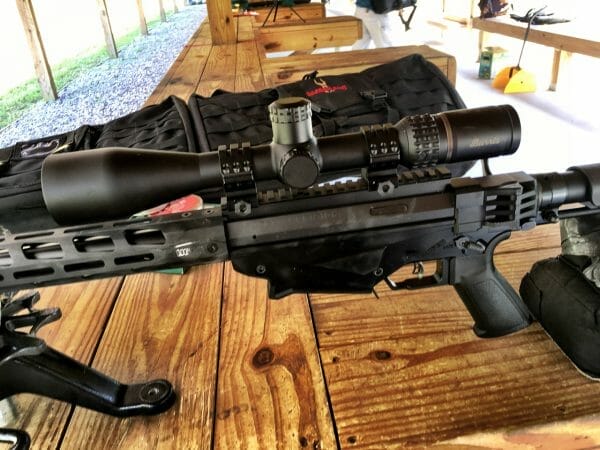
USA –-(Ammoland.com)- If you’re going to shoot long range, you need to make sure your zero is perfect. Small errors at 100 yards become big ones at 1,000 yards, so if your zero is off by just ½-inch at the 100-yard mark, you’re talking five full inches down range.
We’re going to take a close look at the Ruger Precision Rifle in this long range shooting series of articles, so today we’ll take it to the range for its first outing to get a proper zero. There are lots of ways on how to zero a scope and rifle; this is just the method I prefer. It’ll take more than a couple of shots, but you’ll be confident you’re dead on when you stretch out the distance of your shots.

Mounting the Scope
While we won’t go through the process of mounting a scope here, it’s important to mention one important part of the process—ensuring that your scope is level with your rifle. The vertical crosshair must be perfectly aligned with the vertical centerline of your firearm.
At closer ranges, a less than vertical crosshair won’t matter all that much. However, at longer ranges, a slight misalignment will cause a lateral miss. For example, a single degree of scope cant error can shift your point of impact by five inches at 1,000 yards.
You can check the level of your crosshairs by making sure your rifle is perfectly level and then lining up the vertical crosshair with an object that you know is dead on vertical. Or you can use a tool like the Scope Setter.
Methodical Zeroing vs. Quick and Dirty Solutions
If you’re going to do most of your shooting at less than a couple hundred yards, or perhaps you only care about shorter-range minute of beast hunting accuracy, then quick and dirty methods like the “one-shot zero” and similar methods are fine.
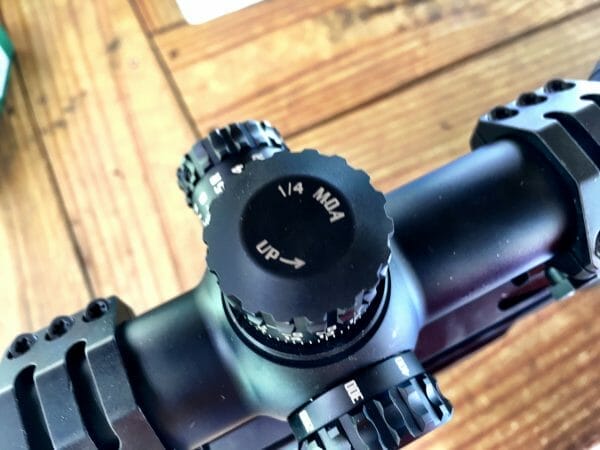
However, tiny errors at 100 or 200 yards become big ones at 1,000 yards, so it’s important to use a more methodical process. Don’t rely on single-shot indicators to determine your zero status. I like to use three-shot groups at each step along the way, except for the initial “get on paper” shot at 25 yards. Using three shot groups allows you to find a decent average impact point given the mechanical variability in your scope, rifle, and ammunition combination. It also helps factor out shooter error. If three shots land in the same area, you can be fairly confident that both you and your equipment agree.
Use the Math when learning How to Zero a Scope for Long Range Shooting
87% of people learning how to zero scopes at the range use trial and error to zero their optics. You’ve seen it. Fire a shot. Look at the target. Spin the turrets one way. Fire again. Spin them the other way. 25 shots later, they’re still chasing the perfect settings.
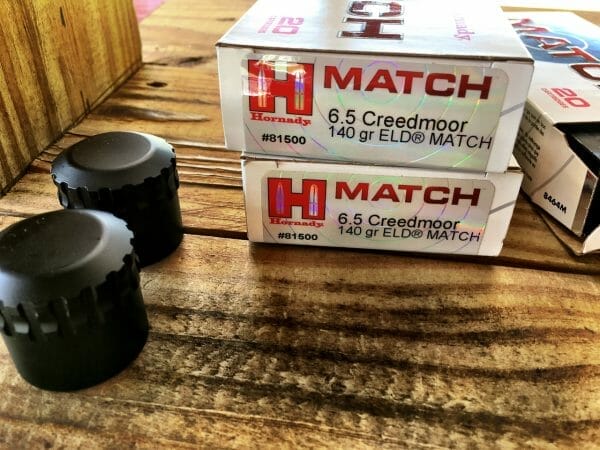
Fortunately, all of that trial and error is completely avoidable because scope turrets give you all the information you need to make an accurate adjustment on the first try. Most scopes have turrets marked with something like “1 Click = ¼-inch.” Sometimes you might see a marking like “1/4 MOA.”
Here’s what it means. When shooting at 100 yards, each click will move the bullet impact ¼-inch in the direction indicated. Scope measurements like minutes of angle (MOA) and mils (milliradians) are proportional, so if you’re shooting at half the distance, each click will move the point of impact half as much. At 50 yards, that click will move the point of impact by one-half of one-quarter of an inch, or 1/8th of an inch. At 25 yards, it would be one-fourth of one-quarter of an inch or 1/16th of an inch. It works the other way too. If you’re shooting at 200 yards, just double the adjustment impact. One click will move the bullet hole two times a quarter of an inch, or ½-inch. Make sense?
Some scope turrets are marked in milliradians, most commonly “1 click – .1 mils.” A “mil” represents 3.6 inches at 100 yards, so .1 mils is .36 (about 1/3) of an inch at that distance. At 50 yards, it’s ½ times .36 inches and so on.
So, when adjusting, you can quickly determine how many clicks are required to get your rifle, in this case the Ruger Precision Rifle on target by looking at how many inches “off” you are. Hold this thought for a hot second and we’ll come back to it as we continue the process below.
Get on Paper at 25 Yards
After mounting a new scope, you really have no idea where the first shot will go. Rather than putting a target far down range and hoping for the best, move your first target up close to 25 yards. You will almost certainly hit the paper somewhere before you make any scope adjustments.
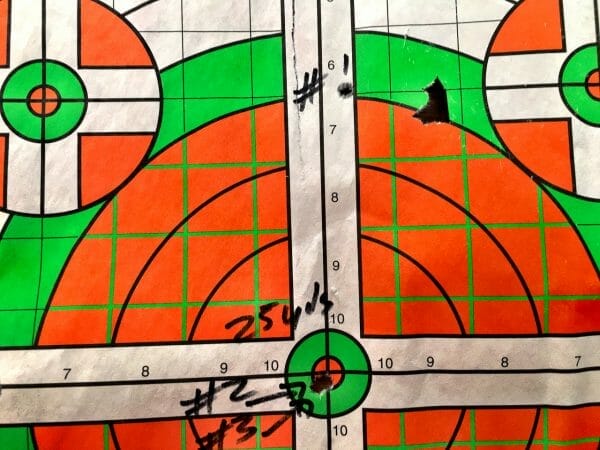
Using the math described previously, you can make some rough adjustments to get close to the bullseye at this close range. Let’s walk through the process with a brand-new Ruger Precision Rifle chambered in 6.5mm Creedmoor.
Heads up—one of you will own this rifle when it’s given away later at the end of this long-range shooting article series, so keep an eye out on this monthly newsletter!
I mounted a Burris Veracity 4-20×50 scope I had handy on the rifle for the first range outing. This optic has target turrets that adjust in ¼ MOA increments per click, so when shooting at 100 yards, each click moves the point of impact ¼-inch. I fired my first shot at the target from 25 yards to get on paper and the bullet was dead center laterally but almost exactly four inches above the bullseye. Hey! Easy math! To move impact down four inches at 25 yards, I calculated 64 clicks “down” per the direction indicator on the turret. Since each click moves the impact ¼ inch at 100 yards, then that would be 16 clicks—if we were shooting at 100 yards. However, since we’re shooting at 25 yards or one-quarter of the distance, each click has 1/4th the amount of movement at 25, so we have to multiply our clicks by four. I counted off 64 clicks “down” and fired two more shots at the 25-target. Those impacts were right on the bullseye and went into the same hole. Yay Ruger Precision Rifle!
100 Yard Confirmation
Now that I was safely on paper and pretty darn close, I moved the target out to 100 yards and fired a three-shot group. As a quick side note, check the photo on that. All three bullets went into the same hole about 1½ inches low and 1/2-inch left. Three shots don’t make an accuracy test, but I was impressed. Acording to my Lyman Dial Caliper that group measured 0.076 inches. Yes, less than 1/10th of an inch. Anyway, doing the math again, I adjusted 6 clicks “up” and 3 clicks “right” to compensate, then fired another three-shot group. That group landed dead center in the bullseye and measured an astounding 0.046 inches.

Seeing how closely the three shot groups landed, I fired a quick five-shot group and measured a 0.296-inch center-to-center pattern. I’m really looking forward to evaluating this rifle—it’s a tack driver.
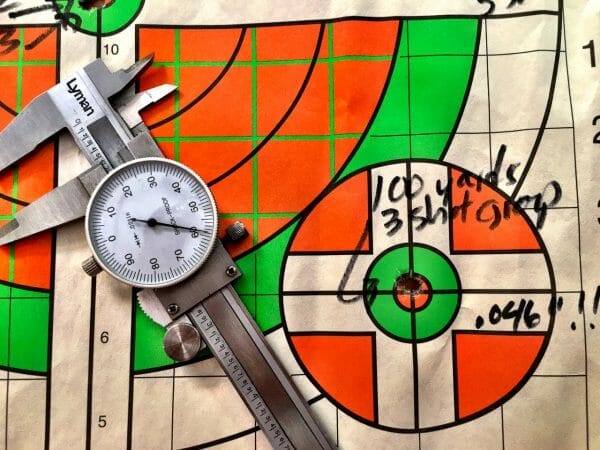
I zeroed this scope and rifle at 100 yards for convenience, not because 100 yards is the best all-around solution. Depending on caliber, optics, and intended use, it may make sense to zero your rifle at 50, 100, 200, or even 300, but that’s a topic for another day.
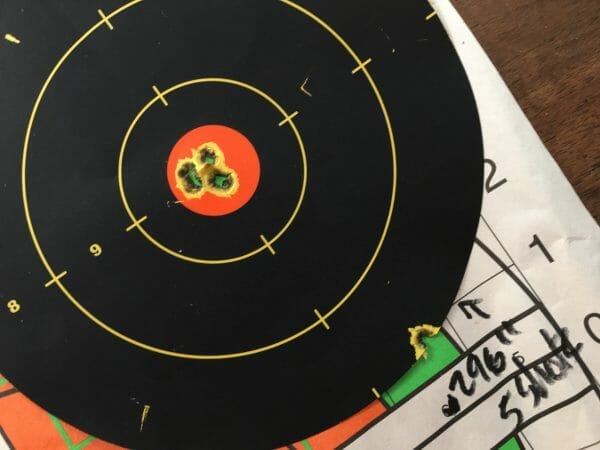
I didn’t include a final step, long-range confirmation, in this how to zero a scope article, because that’s a separate topic. Initially, we wanted to ensure that the rifle and scope were correctly aligned and you can do that at any reasonable short-range distance like 50, 100, or 200 yards. Before launching long-range shots that count, you’ll need to complete a second verification process to figure out which specific scope adjustments are required for different distances down range. That’s not really a scope “zeroing” issue as much as one of calibrating scope adjustments and bullet velocity, so we’ll cover it later in the series. Stay tuned!

About Tom McHale
Tom McHale is the author of the Practical Guides book series that guides new and experienced shooters alike in a fun, approachable, and practical way. His books are available in print and eBook format on Amazon. You can also find him on Facebook, Twitter, Instagram and Pinterest.

All good info but I don’t understand how, “I didn’t include a final step, long-range confirmation, in this how to zero a scope article, because that’s a separate topic” is a separate topic from an article entitled “How to Zero a Scope and Rifle for Long Range Shooting”. If that’s true, you could have stopped at the 25yd range.
I found a very quick and dirty way to get on target within 3 shots and here it is. 1. Get a very steady rifle rest like a Lead Sled. Place it on the bench and secure it so it won’t move. 2. Take your target out to 25 yards. Use an easy to see the target, like an orange center target. Easier to see the holes. One with inch lines won’t hurt the cause either. 3. Making sure the rest is as secure as possible. Then be sure the rest is adjusted so the crosshairs of the scope are… Read more »
That’s the best way to achieve mechanical zero (MZ) next you need to put the rifle in the actual shooting position you and with the actual ammunition you will use at the effective range of you’re ammunition. If you’re POI is the same that’s great. It’s likely you will need to make some adjustments. It’s the same issue with shooting from a bench rest on a hard table, or from a prone soft rest or from Just the sling. The biggest difference on a hard bench the rifle will bounce. From the soft rest or sling it won’t.Also you have… Read more »
Old Marine >>> Jack A Furbush An excellent Scope for Fast target selection at unknown range (reasonably priced ) is the Shepherd / Salvo scope 2016 DRS 3×10 P1A $799.00 $599.00. The Only 100% made in USA scope and the only one to grind there own glass. Check out at>>> https://shepherdscopes.com/product/2016-drs-3×10-p1a/ which is the easiest scope to zero. Biggest scope manufacture in the world made especially for your ammo. These scopes are made by a company that makes both military and industrial optical equipment. Defense customers also > https://salvodefense.com/ I own 2 of these scopes and find that the technology… Read more »
Surprised there was no mention of verifying “mechanical zero” of the scope itself prior to even starting the sight in process. May not be needed with brand new scope but you never know. Turn the windage adjustment all the way till it stops, then count the number of full and partial turns till it stops going the other direction. Divide by 2 and dial that value on the knob/turret. Repeat for the elevation knob/turret. This should give you “mechanical zero” ie reticle zeroed at the halfway point for windage and elevation within the scope tube. Was always told years ago… Read more »
Rifle + Ammo = seriously accurate. Lousy ammo but accurate rifle = lousy accuracy.
And also vice versa. No ammo can make an inaccurate rifle into a good one. It’s the big challenge of long range hits. It takes a good rifle, good ammo that fits the gun, a good stock that fits the shooter, a projectile that likes the rifling, knowing one’s ballistics, doping out the wind, on and on. Long range hits require all of these various elements to blend together perfectly to make a hit. A long range hit is kind of like a complex recipe, dozens of ingredients must all blend together perfectly to make it work. That’s why it’s… Read more »
Excellent article! Look forward to more.
PS. Great shooting
Great info. What height are the rings? I have an 8-32×56 stightron and it will be moving from my 6.5 Ruger predator to the Gen III Ruger Precision.
Zeroing can be easier. Method: Dial the cross-hair to your POI. We just zeroed a Tikka T3 in .308 Win. Rifle was placed on secure front rest and rear bag. 1. One shot at 50 yards to confirm on paper and within size of grid target. 2. Move to 100 yards. One shot fired at center of target 3. With gun secured, and center of reticle starting right on center of target, you dial the crosshairs to the location of 100-yard bullet hole one. In our case this was down about 6 inches and left about 4 inches. 3. Second… Read more »
You can’t accurately measure a group from a photo, calibration or not. Lens distortion and the fact that the caliper dial is much closer to the lens than the paper completely throws off your distances. I measure close groups like this by outer edge to outer edge, then subtract the diameter of the bullet to get a center to center measurement. I’ll stand my my actual measurement before relying on measurement of a photo image.
McHale’s method is incorrect. The reason is the bullet hole in paper is normally smaller than the nominal bullet diameter. That is why special optical reticles are using when scoring in matches. You center the bullet hole inside the measured circle. That is how the On-Target software works. I score targets for rimfire and centerfire benchrest matches. I’ve seen and scored true zero groups. The claimed 0.076 is not one. Another method is to measure ONE bullet hole as it appears on the paper of your target. Then subtract that number from outside edge to outside edges.
Yeah – but my dick is bigger
Come on now, my dick is much larger.
Personally, I use Stanley Workmate (TM) that gets bolted to a concrete pad at 200 Yards, fitted with felt lined jaws to protect the rifle. Use the machine’s adjustments to get on the paper then dial the scope in to meet the POI. I own a RPR chambered in 6.5 Creedmoor and after taking my time to get my setup right, I can get sub 0.230 groupings at 200 yards. (Prone, off the bi-pod.) Given the RPR’s capability for long range accuracy, I’ve been tempted to stretch the range out to 500 yards (Easy to do in a field, just… Read more »
Good article. Everyone is so up on the 6.5…do you have any sighting info for the RPR in .308 Win?
Great article! I recently got a Kel-Tec RFB and put a Leatherwood CMR-4 on it. It’s my first “long” gun, and my first time using an optic, and actually just went to the range with it 2 days before this article was posted. Spent an embarrassing amount of time turning the knobs back and forth and pulling the paper forward and seeing little change. Finally after about 20 shots, I payed attention to the text around the edge of the top turret: ‘1 click = .36″ @ 100 yds.’ pulled the paper forward, too a measurement, did some math (I… Read more »
Great article, with helpful information for all. Also good info in comments as well. As my dad used to say, ” Do it right the first time son, so you don’t have to like your calf over”.
I prefer 100 yard starting zero. Helps to bore sight with my bore laser calibrated to a gun already sighted in. Laser sights can show variance as they are turned in the bore. Use a sighted in gun, turn the laser until it lines up and mark it with a marker. Now your ready for initial sight in.
After 100 yards I go to 300 yards and recalibrate on a windless day.
This was a very interesting and Informative article. I cannot wait to read the rest of the seriesyou will have coming. The photos and explanations go a long way in assisting me thanks.
Interesting article. I am still figuring out how to use optics. We, as in Marines, never used them to qualify. Had to use iron sights and smudge pots. 3 shots at 200 yds sitting to get your “dope” and you were off to the races. Thanks again for an interesting article
I sights on my .308 at 100 yds, adjusted elevation to hit 34″ high. Then at 1000 yds, I was on target. I was very proud of that shot.
Spot on. The military M118 match round issued to both Marine and army snipers has a drop of 48 inches depending on the lot. The new M855 has only a 30 + inchs
Nice and straightforward episode, Tom. Looking forward to the series. I have an RPR in 6.5 Creedmoor, with a 5×20 FFP Vortex in MOA reticle. Both still waiting on me to find the range time. This will be interesting.
Thanks, Tom. Great article. I cannot claim to be a precision long range rifle shot. My range only has 100 yard rifle and 200 yard if they close another range. However, I’ve had good luck using a boresight laser, which I have readily available. You can get virtually a one shot zero by putting the boresight laser in, and dialing the scope cross hairs onto the laser spot at your sighting distance. Might take a click or two to get perfect zero (given laser divergence, and spot size), but it is a quick way to be in close before a… Read more »
Download 30 and 50 yard adjustable zero targets. If you don’t have access to 100yd range, you can get that zero.
Google adjusted zero target, for ar and ak platform and others.
The military method for zero on both .30 cal and 7.62 caliber weapons on a short range iOS the 1000 inch ( 26 yards ). This will give you a battle zero at 250 yards. With the 5.56 round at 50 yard zero will give you a battle zero at 300 yards. This is way the army trains recruits. The Marine Corps is the only branch of the military that has recruits fire in a known distance range at 200, 300, 500 yards course. Every Marine is a basic rifle man regardless of MOS and must qualify every year with… Read more »
Excellent point and thanks for the lead in. We’re going to be doing a story in this series dedicated exclusively to calibrating different distances and how to use a data book! What do I owe you for the setup on that? 🙂
That would be great! Any idea when we can expect that article?
Army in 1980 when they still had the od green work uniform, and six weeks basic we qualified with targets from 10 to 300 yrds, and out to 600 on the m60 with me as his spotter my brother as in blood brother we went in together, cud hit a pop up Target with the m60 by making it fire one round at a time at 600 yards, once I walked him in on target with about 3 shots he would hit it Everytime DI,s we’re amazed with his open sight abilities, an by the way he had perfect score… Read more »
Very Nice, would you recommend that specific Burris scope for this rifle?
I stuck that one on just for a zeroing example but it’s a very nice scope for the money. The attributes are good for the caliber as it’s a 20x max magnification scope which (for me) is a pretty good magnification for 6.5mm Creedmoor. While definitely a personal preference I prefer to under magnify rather than over, so I would choose a 15x or 20x over something more powerful. Less mirage and wobble to distract my feeble attention span 🙂 There will be another scope thrown into the mix as we work with this rifle and it will be given… Read more »
FYI,,,there is NOT less wobble,,,just less detectable wobble.
I figured that goes without saying as adding a scope can’t do anything about impacting the actual physical movement of the rifle, hence my crack about my feeble attention span 🙂
I sight either of my Rugers (6.5 & 6.0mm Creedmoore) at 25 yards by securing the rifle to a stand and aiming at the bull and taking the first shot and then with the rifle still secured and pointing at the original bull, turn the scope adjustment(s) so that the cross hair(s) are on the bullet hole, and then re-aim the rifle at the bull again after loosening the secured rifle and then take your second shot at the bull with your new scope settings and you should see the second hole exactly in the center of the bull if… Read more »
on the 5 shot target was one a flyer? it looks like only 4 went in the bull and you have one at about 5 30 at the bottom of the target but no mention of it. its pretty impressive grouping but just curious about the flyer.
I see where you made an error. Look the bullet hole at approx 1600 and you will see it is elongated indicating 2 shots
The same is seen at 2100 and a single hole at approx 1300
Based on my observations and and Mark 3 eyes I would say all five enter the bull, and the shooter was reusing a target.
No, sorry for the confusion. The hole on the left is three shots with the other two to the right. All five were in the Orange. The target sticker was placed elsewhere at the range and that bottom hole is from unrelated shooting. The black target is just laying on top of the paper one for the photo.
Uggh, my right / left confusion reigns again.. As Marvin says correctly the three holes are on the RIGHT and two on the LEFT.
I’ve switched to a digital protractor for scope leveling. Much much more precise than a bubble level, though that precision will have your frustration level going up when tightening down your rings 😉
How do you use a protractor to level your scope?
I think he meant one of these:
https://www.trick-tools.com/Digi-Pas_DWL-2000XY_2-Axis_Digital_Level_DWL2000XY_5149
They have lots of names, digital levels, machinist’s levels (as a gunsmith/machinist that’s what I know them as), angle gauges, etc.
They are really TOO accurate for scope leveling, as mentioned. The one I linked is to 1/100th of a degree, but mine is only to a 1/10th of a degree and it’s plenty, even for leveling up lathes and mills. And mine wasn’t 500 bucks either! I think it was a hundred or so, years ago. Probably less by now.